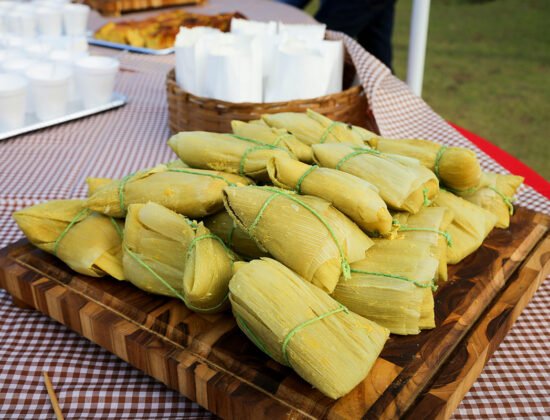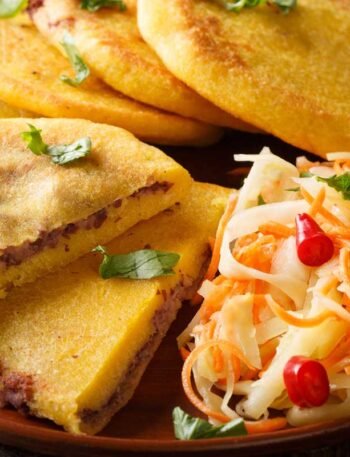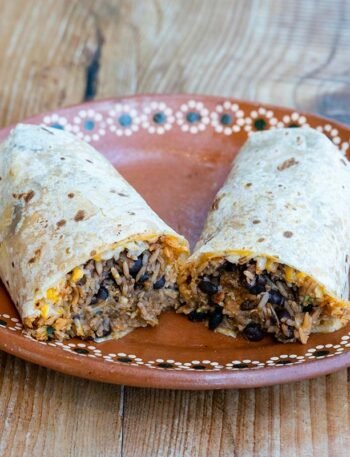Tamales are one of the most popular Latin foods. There are many varieties. Tamales are made from corn masa, often stuffed with meat or sauces, then wrapped in either banana leaves or corn husks, then steamed.
Their history goes back to ancient Mesoamerica, where the Maya and Aztecs commonly prepared them. Today, tamales remain a staple across the region, with each country offering its unique styles, fillings, and cultural significance.
What Are Chuchitos?
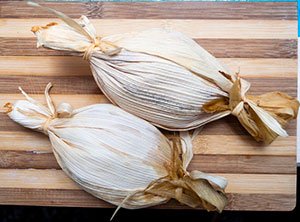
Chuchitos are a Guatemalan variation of tamales and are especially popular at parties, fairs, and street food stands. The name roughly translates to “little dog” in Spanish, although no one is certain why. Chuchitos are smaller than regular tamales. They are made with a firmer, slightly drier corn masa. The masa is often flavored with a tomato-based sauce called recado and filled with a small portion of pork or chicken. They’re wrapped in dried corn husks, tied at the ends, and steamed. Once cooked, they’re typically served with a bit of tomato salsa and crumbled white cheese. Their size makes them perfect for snacking.
Tamales in Mexico
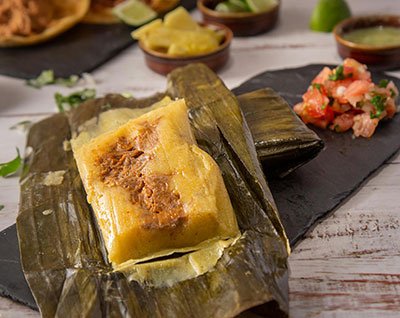
In Mexico, tamales are nearly a way of life. There are hundreds of regional varieties. Some are wrapped in corn husks, while others come wrapped in banana leaves, depending on the region and the specific type. Fillings can include pork in red chile sauce, chicken in green tomatillo salsa, beans and cheese, rajas (chile strips), or even sweet combinations like pineapple and cinnamon. In the Yucatán, tamales are often colored with annatto and wrapped in banana leaves. In Oaxaca, tamales are commonly filled with black mole and chicken and steamed in broad banana leaves.
In Michoacán, triangular tamales called corundas are made with unfilled masa and steamed in long green corn leaves. It is common to see them with cream and salsa. Veracruz and Tabasco are known for chanchamitos, small, round tamales with reddish masa due to annatto seasoning and usually filled with pork.
One of the most distinctive types is the zacahuil, a massive tamal from the Huasteca region that can weigh up to 30 pounds! They are often made for large gathering such as weddings and festivals. It’s filled with pork, baked in a clay oven, and served in large slices. Tamales in Mexico are eaten for breakfast, lunch, or dinner and play a central role in celebrations like Christmas, Día de la Candelaria, and Día de los Muertos.
Guatemalan Traditions
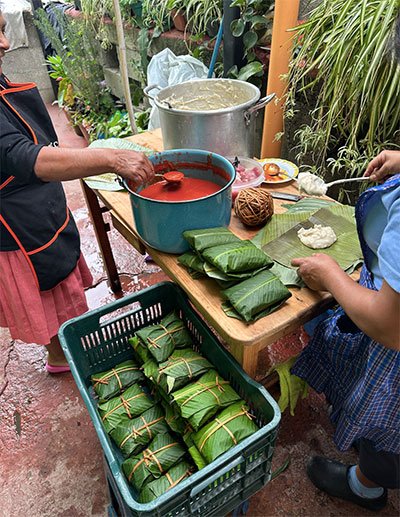
Guatemala’s tamales are just as rich in variety. Beyond chuchitos, tamales colorados are a classic version made with a smoother, softer masa. They are usually filled with pork or chicken, sweet red bell peppers, all wrapped in banana or maxán leaves and steamed. The result is a flavorful tamal with a slightly sweet and earthy aroma from the leaf.
Tamales negros are a sweeter holiday version. They contain the same soft masa but include additional ingredients such as chocolate, raisins, almonds, and prunes. People typically serve these around Christmas and other special family celebrations.
Another popular variation is paches. Made from mashed potatoes instead of corn masa, paches are wrapped in banana leaves and usually filled with pork and a red recado. They’re commonly eaten on Thursdays, often as part of a weekly tradition in Guatemalan households.
Tamales in Other Latin American Countries
Across Latin America, tamales continue to take different forms. In Colombia, tamales are typically large and include a mix of rice, vegetables, chickpeas, hard-boiled egg, and meat. They’re wrapped in banana leaves and often eaten for breakfast or during holidays.
Ecuador has several versions, some made with corn masa and others with morocho, a type of cracked corn. Tamales in Ecuador are often wrapped in achira leaves or banana leaves and can be filled with pork, chicken, or cheese. Sweet versions include fresh corn and sugar.
Cooks in Peru typically make tamales with yellow or white corn masa and often add ingredients such as peanuts, olives, and hard-boiled eggs. One popular variation is tamal verde, which is made with herbs like cilantro and spinach to give it a green color and distinctive flavor. Peruvian tamales are commonly served with salsa criolla, a tangy onion relish.
Nicaragua is home to nacatamales, which are considered a full meal wrapped in a banana leaf. The filling includes seasoned pork, rice, potatoes, tomatoes, green peppers, olives, and sometimes raisins or mint. Yoltamales, another Nicaraguan variety, are made with fresh corn and tend to be simpler, sometimes sweet, sometimes savory.
In El Salvador, tamales de elote are made with sweet corn and can be served plain or with sour cream. Tamales pisques are filled with refried beans and often eaten as breakfast. In Panama and the Dominican Republic, tamales are also highly regarded, with variations that reflect influences from African, Spanish, and Indigenous cultures.
Chuchitos vs. Tamales: A Quick Overview
- Chuchitos (Guatemala): Firm masa, tomato recado, pork or chicken, corn husk. Snack size.
- Tamales Colorados (Guatemala): Soft masa, meat and vegetables, banana leaf. Main meal.
- Tamales (Mexico): Wide variety of fillings, corn husks or banana leaves. Daily and holiday food.
- Tamales (Colombia): Includes rice, vegetables, egg, chickpeas, and meat. Banana leaf. Large.
- Tamales (Peru): Masa with peanuts, olives, egg, sometimes herbs. Yellow or green masa.
- Nacatamales (Nicaragua): Pork, rice, veggies, raisins, mint. Banana leaf. Full meal.
How to Make Tamales
- Soak the wrappers: Soak corn husks or banana leaves in hot water until they become soft and flexible.
- Prepare the masa: Use masa harina or freshly ground corn. Mix with broth and fat, such as lard or vegetable oil.
- Make the filling: This can be anything from spicy meat stews to vegetables, cheese, or sweet mixtures like pineapple and cinnamon.
- Assemble: Spread the masa on the wrapper, add filling, then fold and tie.
- Steam: Place in a large steamer and cook until the masa is set and separates easily from the wrapper.
Why Tamales Matter
Tamales are more than food. They’re a cultural symbol that brings people together. In many households, tamales are prepared as a family, especially during holidays. One Mexican tradition is the tamalada. In this tradition, families and friends gather to make dozens of tamales to either sell at local markets or to freeze for later.
In Guatemala, the appearance of a red lantern outside a home means that tamales or chuchitos are being sold, often on weekends or holidays.
Corn, the base of all tamales, is sacred in indigenous cultures. Among the Maya and Aztec peoples, corn was seen as the food of the gods. People often offered tamales in religious ceremonies, and today, they continue to serve them in both daily life and major celebrations.
Final Thoughts
From small chuchitos in Guatemala to spicy mole tamales in Oaxaca and hearty nacatamales in Nicaragua, tamales showcase the diversity and shared roots of Latin American cuisine. Each region has adapted the tamal to local tastes and traditions, but the essence remains the same: masa, a flavorful filling, and a wrap that seals in both flavor and meaning.
Making tamales from scratch is a time-consuming process, but it’s also rewarding. It’s a chance to connect with loved ones, preserve cultural traditions, and enjoy a dish that has stood the test of time. If you haven’t yet, try making or tasting tamales from a different part of Latin America. You might discover a new favorite—and a deeper connection to the culture behind it.

